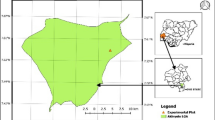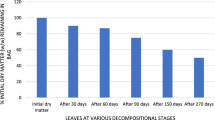Summary
Litter bags, containing bamboo (Dendrocalamus hamiltonii Nees.) leaf litter was used to compare the decomposition rates and microbial populations in litter under fallows of different ages. The age of the fallows were 0,5 and 10 years. All were developed after Jhum (shifting) cultivation.
It was found that the fastest rate of decomposition occurred in the 10 year and the slowest in the 0 year old fallow. Changes in the litter components followed the following trend: sugar > amino acid > hemicellulose > cellulose > lignin.
Great fluctuations from month to month were found in the number of microbes. They reached their maximum during the rainy season. However, there was little variation in the composition of fungal taxa. Species of Penicillium, Trichoderma, Aspergillus, Cladosporium, Alternaria, yeasts and a dark sterile mycelia were dominant.
Similar content being viewed by others
References
Alexander M 1961 Introduction to soil microbiology. John Wiley and Sons, Inc., New York.
Anderson J M 1973 The breakdown and decomposition of sweet chestnut (Castanea sativa Mill.) and beech (Fagus sylvatica L.) leaf litter in two deciduous woodland soils. I. Breakdown, leaching and decomposition. Oecologia 12, 261–274.
Bocock K L, Gilbert O J, Capstick C K, Twinn D C, Waid J S and Woodman M J 1960 Changes in leaf litter when placed on the surface of soils with contrasting humus types. I. Losses in dry weight of oak and ash leaf litter. J. Soil Sci. 11, 1–9.
Cuevas V C and Uyenco F R 1977 Mycoflora of decomposing leaf litters. Nat. Appl. Sci. Bull. 29, 107–169.
Edmonds R L 1979 Microbiological characteristics of dewatered sludge following application to forest soils and clear cut areas.In: Utilization of municipal sewage effluent and sludge on forest and disturbed land. Eds. W E Sopper and S N Kerr. Penn. State University Press, University Park, 537 p.
Ewell J J 1971 Biomass changes in early tropical succession. Turrialba 21, 110–112.
Ewel J J 1976 Litterfall and leaf decomposition in a tropical forest succession in eastern Guatemala. J. Ecol. 64, 293–308.
Frankland J C 1966 Succession of fungi on decaying petioles ofPteridium aquilinum. J. Ecol. 54, 41–63.
Gosz J R, Likens G E and Bormann F H 1973 Nutrient release from decomposing leaf and branch litter in the Hubbard Brook Forest, New Hampshire. Ecol. Monogr. 43, 173–191.
Grigal D F and McColl J G 1977 Litter decomposition following forest fire in northeastern Minnesota. J. Appl. Ecol. 14, 531–538.
Ivarson K C 1973 Fungal flora and rate of decomposition of leaf litter at low temperatures. Can. J. Soil Sci. 53, 79–84.
Lawrey J. D. 1977 The relative decomposition potential of habits variously affected by surface coal mining. Can. J. Bot. 55, 1544–1552.
Lawrey J D 1978 Trace metal dynamics in decomposing leaf litter in habitats variously influenced by coal strip mining. Can. J. Bot. 56, 953–962.
MacLean D A and Wein R W 1978 Weight loss and nutrient changes in decomposing litter and forest floor material in New Brunswick forest stands. Can. J. Bot. 56, 2730–2749.
Nye P H and Greenland D J 1960 The soil under shifting cultivation. Tech. Comm. No. 51, Comm. Bur. Soils, Harpenden.
Olson J S 1963 Energy storage and the balance of producers decomposers in ecological systems. Ecology 44, 322–331.
Peach K and Tracey M V 1955 Modern methods of Plant analysis (ed.) Vol. I. Springer Verlag, Berlin, 542 p.
Singh K P 1969 Studies in decomposition of leaf litter of important trees of tropical deciduous forests at Varanasi. Trop. Ecol. 10, 292–311.
Van Cleve K 1974 Organic matter quality in relation to decomposition.In Soil organisms and decomposition in tundra. Eds. Holding, Heal, MacLean, Jr., and Flanagan. Swedish IBP Committee. Stockholm, Sweden, pp 311–324.
Zinke P J, Sabhasri S and Kunstadter P 1970 Soil fertility aspects of the Lua forest fallow system of shifting cultivation. International seminar on shifting cultivation and Economic Development in Northern Thailand, Land Development Department, Bangkok, Thailand. pp 251–293.
Author information
Authors and Affiliations
Rights and permissions
About this article
Cite this article
Deka, H.K., Mishra, R.R. Decomposition of bamboo (Dendrocalamus hamiltonii Nees.) leaflitter in relation to age of jhum fallows in Northeast India. Plant Soil 68, 151–159 (1982). https://doi.org/10.1007/BF02373701
Received:
Revised:
Issue Date:
DOI: https://doi.org/10.1007/BF02373701




